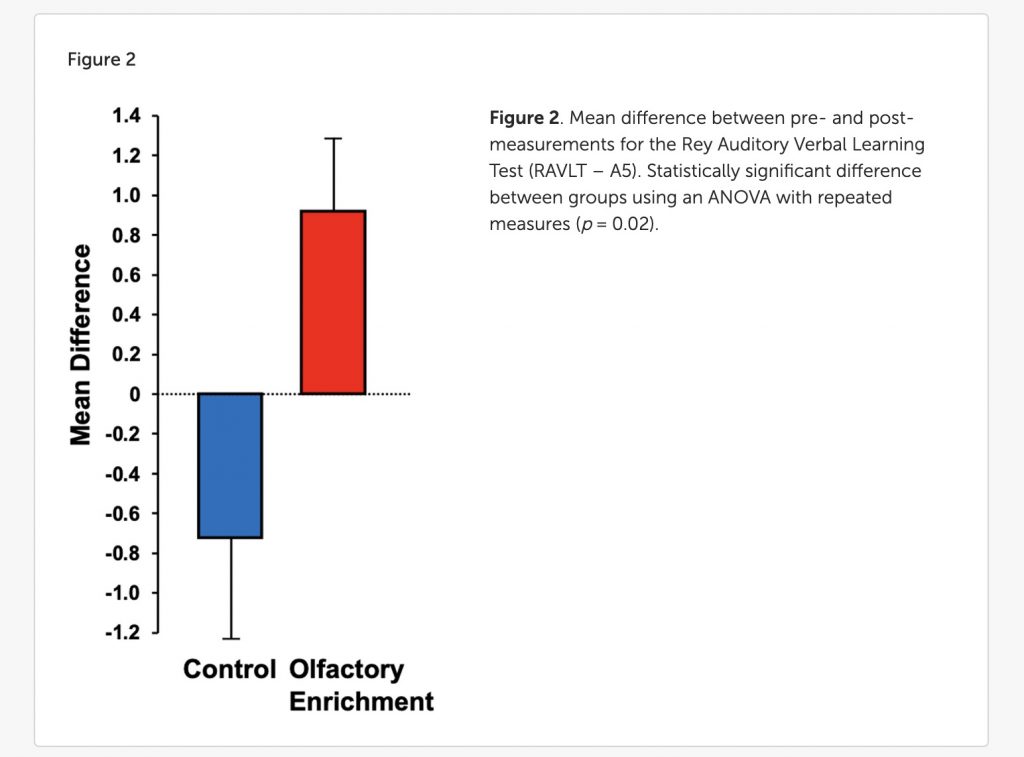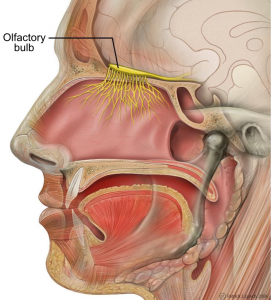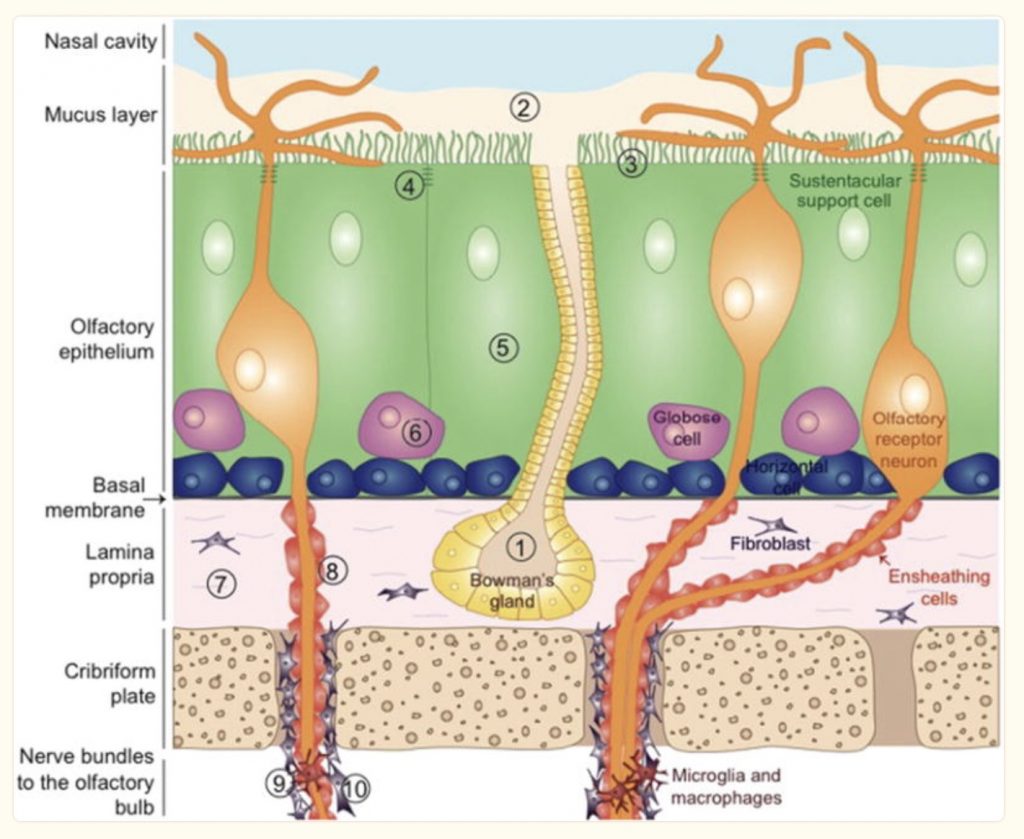Neurogenesis refers to the formation of new neurons in the brain, a process that is abundant during development.
Researchers have now discovered that neurogenesis also occurs in adults, and a lack of neurogenesis may play a role in neurodegenerative diseases. Intriguingly, this process involves the olfactory bulb, which is the part of the brain that is stimulated by odors.
Here’s what started me down this path…
Improved cognitive function through odorant stimulation at night:
A recent study of cognitive function in older adults showed that stimulating the olfactory nerves by smelling different odors at night while sleeping could promote better cognitive function. In a nutshell, older adults were exposed to different odors each night of the week while they slept using essential oils in a diffuser. This was repeated for 6 months.
Cognitive scores after 6 months showed a 226% improvement (!) on the auditory verbal learning test compared to the control group with no odorants. fMRI imaging showed changes in the uncinate fasciculus, which is the fiber tract that connects the frontal lobe to the temporal lobe. It’s a really cool study — you can read it here.

There are, of course, other studies of learning and brain changes based on smelling different odors.
For example, several studies of olfactory training for PTSD show efficacy, with 36% of patients achieving clinically significant improvements.[ref] Another study of dementia patients also shows improvements with sniffing 40 different odorant sticks, twice a day. This intensive olfactory training “showed significant improvements in depression, attention, memory and language functions, but not global cognition, frontal executive, or visuospatial functions compared with the control group.”[ref]
In addition, reduced olfactory ability has long been known to be a predictor of neurodegenerative diseases such as Parkinson’s.
These olfactory studies led me down the rabbit trail to look at the odor-sensing region of the brain called the olfactory bulb. It sits at the bottom of the forebrain, right above the nasal passages, and it may hold the key to adult neurogenesis…

Animal studies on neurogenesis and odorants:
While the adult brain isn’t as well known for its regenerative properties, in animals there are hundreds of studies on the abundant neural stem cells in a region called the ventricular–subventricular zone (V-SVZ). Neuronal stems can migrate from that region between the brain ventricles to the olfactory bulb. In the olfactory bulb, they can differentiate into local neurons. For a long while it was thought that this same mechanism didn’t apply to humans, however, newer research shows that neurogenesis does happen in adults.
In addition, animal studies over the past decades showed that olfactory enrichment by exposure to multiple odorants could improve brain function and behavior.
This is driven in part by adrenergic receptor activation in the olfactory bulb. Blocking the α1-β adrenergic receptor in mice prevents perceptual odorant learning but not associative learning.[ref] In a mouse model of Alzheimer’s disease, which also has impaired olfaction, researchers found that GABA is involved. The mice showed impaired olfactory behavior well before the onset of plaque formation in the brain. This was due to reduced olfactory sensory neurons and altered GABA receptor activation. A GABA uptake inhibitor ameliorated the issue, pointing towards aberrant GABAergic signaling in the development of Alzheimer’s and the loss of olfaction.[ref]
Human studies on adult neurogenesis:
Research in recent years shows that the olfactory neuroepithelium – the area between the lining of the nose and the brain – contains neural stem cells in humans. A 2020 paper in Nature details that the olfactory neuroepithelial niche may provide neurons for the brain in adults.[ref] Neural stem cells in adults mainly come from the subventricular zone and migrate toward the olfactory bulb, and another reservoir is found in the hippocampus.[ref][ref]
Another study showed that immature dentate granule cells do exist in the human hippocampus and may play a role in plasticity throughout life. Alzheimer’s patients were found to have fewer of these precursor neurons. From an interview with the researchers: “Immature neurons in the hippocampus were and continue to be of particular interest, since this brain region play major roles in learning, memory and mood regulation, and are reduced in the brains of people with Alzheimer’s disease.”[ref][ref]
New tissue sampling methods allow researchers to identify immature neurons that formed in the hippocampus, showing neuronal growth in adults up through age 90. The research showed that in people with Alzheimer’s, there is a sharp contrast with neurogenesis rapidly declining as the disease progresses. The conclusion of the researchers was that this provides “evidence for impaired neurogenesis as a potentially relevant mechanism underlying memory deficits in AD that might be amenable to novel therapeutic strategies.”[ref] Animal studies support this by clearly showing that impaired adult neurogenesis likely occurs early in the pathology leading to Alzheimer’s disease.[ref]
This isn’t just about dementia…
Chronic neuroinflammation is thought to cause olfactory dysfunction in people with mental illness. Researchers have found that inflammation initially damages olfactory neurons, and the chronic continuation of inflammation locks the stem cells in an undifferentiated state. [ref][ref]
Odor receptors, odors, and the olfactory bulb:
Odor receptors are found on the sensory neurons in the lining of the nose. Humans have hundreds of different odor receptors that are activated by about 4,000 odorant compounds. Interestingly, these receptors are actually found throughout the body and are involved in cell-to-cell signaling, cell proliferation, and more.[ref]
Women have almost 50% more olfactory bulb neurons and glial cells than men do.[ref] I wonder if this is one reason why women, on average, live longer than men.
How does odor exposure cause neurons to grow?
Research shows that stimulating the olfactory bulb and learning to discriminate between odorants is part of how newly generated neurons differentiate and survive. Without the stimulus from odors, the newly generated neurons are likely to undergo apoptosis.[ref]
I mentioned that a reduced ability to smell is associated with neurodegenerative diseases, such as Parkinson’s. Researchers used transgenic mice that overexpress the human version of the alpha-synuclein gene, mimicking Parkinson’s pathology. The results show that the overexpression of alpha-synuclein causes impairment in olfactory bulb neurogenesis.[ref]

What happens if the olfactory bulb is injured or exposed to a toxicant?
Concussions and repeated traumatic brain injuries can cause Parkinson’s in some people. A 2022 paper showed that olfactory bulb glutamate excitotoxicity is a possible mechanism causing decreased neurogenesis in Parkinson’s disease. [ref]
One theory of neurodegenerative diseases (Parkinson’s, Alzheimer’s, frontotemporal dementia, ALS) is the misfolding of proteins in a prion-like fashion. Some researchers theorize that the environmental or pathogenic trigger for these diseases causes prion formation in the olfactory bulb, which then migrates through the brain.[ref]
Does it matter which scent?
The study that used seven different odorants while sleeping – a different one each night over the course of a week – showed that it’s not necessary to actively identify the odor, and that the specific essential oil used may not matter too much.
However, there is an old saying about rosemary being for memory…
It turns out there is research on inhaling specific essential oils and their effect on memory. A study of rosemary essential oil showed that it increases speed on the Stroop test. Researchers also did EEG tests on the volunteers and found that there were detectable changes in brain waves with rosemary exposure.[ref]
A clinical study in healthy adults found that smelling lavender essential oil decreased working memory and impaired reaction times, while rosemary significantly enhanced cognitive performance overall.[ref] Lavender increases GABA, which is an inhibitory neurotransmitter.[ref]
Alzheimer-model mice exposed to Schisandra chinensis essential oil have improved cognitive ability. Researchers determined that the essential oil decreased neuroinflammation by acting on the NF-κB/MAPK signaling pathway.[ref]
Smelling the coffee may do more than just wake you up in the morning. A study involving healthy young adults found that smelling ground coffee for five minutes increased attention, memory, and recall speed – compared to a control group who smelled ground carbon for five minutes.[ref] It also appears to work in animals, with the aroma of roasted coffee beans reducing stress markers in rats.[ref]
Increase olfactory bulb function by reducing inflammation with antioxidants:
Dimethyl fumarate is a derivative of fumaric acid used as an oral medication for multiple sclerosis and being researched for Alzheimer’s. Fumaric acid is available as a natural supplement. It has antioxidant properties. However, a 2022 animal study using a model of Alzheimer’s disease showed that dimethyl fumarate alleviated Alzheimer’s behavior by acting on the olfactory bulb, promoting the formation of new neurons.[ref]
Huntington’s disease is a genetic neurodegenerative disease that causes a progressive loss of striatal neurons. New research is looking at the role of antioxidants in promoting neurogenesis to regenerate the neurons that are lost in Huntington’s.[ref]
Incensole acetate is a major constituent of Boswellia carterii (frankincense). A study found that incensole acetate has the ability to “initiate proliferation and differentiation of neuronal progenitors in hOBNSCs and induce HO-1 expression, thereby protecting the hOBNSCs cells from Aβ25–35-induced oxidative cell death.” HO-1 expression is heme oxiganase, an antioxidant enzyme, and Aβ is amyloid-beta, the protein that is involved in Alzheimer’s.[ref]
Alcohol kills brain cells… In animal models of alcoholism, curcumin has been shown to increase neurogenesis to repair the damage from alcohol consumption.[ref]
Rhodiola extract acts as an antioxidant as well and promotes neurogenesis in animal models of Alzheimer’s.[ref]
High-dose IgG has been shown in mice to decrease inflammation in the olfactory system following head injury.[ref]
Conclusion:
Adult neurogenesis may play an important role in preventing neurodegenerative diseases in aging. Stimulating the olfactory bulb by smelling different odors is an easy and pleasant way to promote neurogenesis.
I think there will be a lot more research coming out on how neurogenesis is involved in healthy brain aging. In the meantime, I’m stopping to smell the roses.
